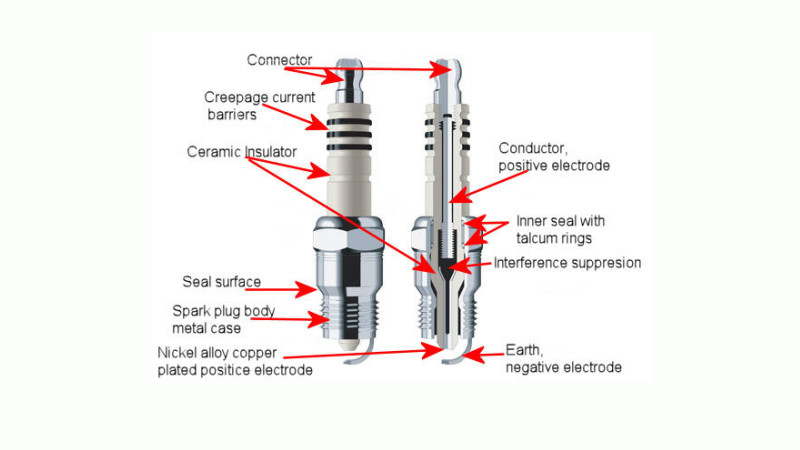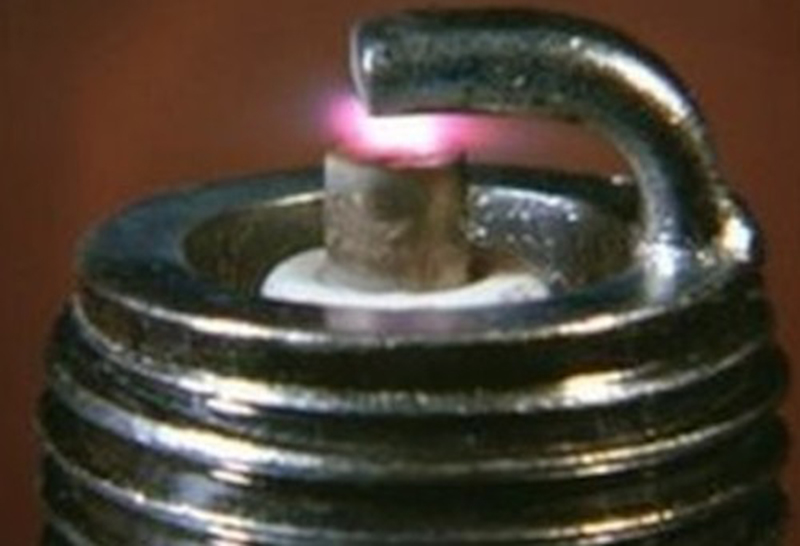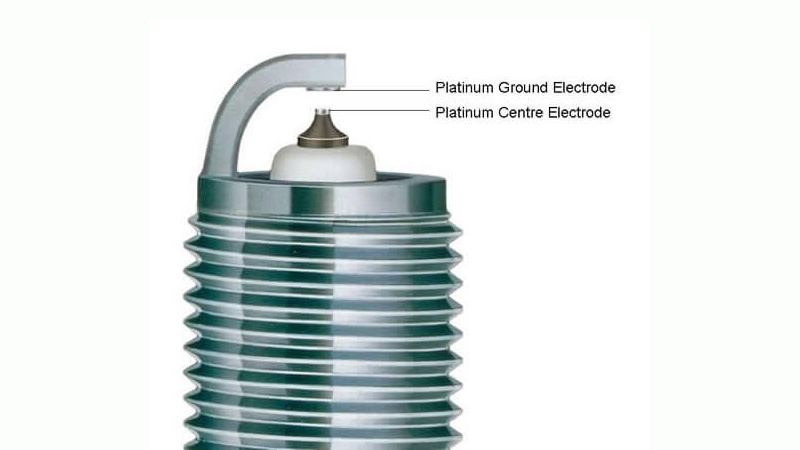This is All You Need to Know About Spark Plugs
Last updated on – Feb 28, 2016
Spark Plugs are considered as one of the necessary functional components required for an internal combustion system excluding for the diesel engines. A diesel engine delivers power via compression ignition. It implies that a small volume of the mixture of air and fuel is compressed down, which ignite the motor. When it comes to petrol, most of the fuel has been burned out through a small spark only. The process works in a rapid chain within an enclosed place.
Read Also: Inline Twin Engine vs Parallel Twin Engine
 Compression stroke is the cycle of an internal combustion system in, which the gases are compressed before sparking. It’s quite obvious that they do a lot in uplifting the temperature for maintaining the efficiency of the combustion. But, as we all know, fire catches up instantly when gets in touch with even a tiny spark. For this reason, it is asked to keep mobile phones inside the pocket at petrol pumps.
Compression stroke is the cycle of an internal combustion system in, which the gases are compressed before sparking. It’s quite obvious that they do a lot in uplifting the temperature for maintaining the efficiency of the combustion. But, as we all know, fire catches up instantly when gets in touch with even a tiny spark. For this reason, it is asked to keep mobile phones inside the pocket at petrol pumps.
Seems like, you all are aware of the spark plugs and what are they used for? Nevertheless, some of the prominent details will help you to know more about its working as well as the external structure of the thing in a more precise manner. In general, the device is made up of a central conductor delivering electric current from the spark cable to the exposed combustion chamber (cylinder head) tip. A positive terminal is also formed from this. Covered via a ceramic insulator, the conductor is normally made of firmed sintered alumina ceramic material. On the exterior part, the bottom has cables connected to the tip and further covered through a plastic ribbon casing for advancing the insulating ability and charge leakage. You can see the model number and the brand over it. A nut is there for tightening the plug, a seal and a thread.
The interesting part over all the above stuff is that the medium amidst this is air, or the blend of a not a really good conductor, air and fuel. The voltage of the spark plug can be anywhere from 20,000 to more than 100,000 volts, which is extremely high in order to generate current.
Read Also: HHO kits raise Motorbike’s mileage, but are they safe?
From this, we’ve reached over a conclusion, defining the complexities when working with a spark plug. First thing is to consider the gap between both the electrode ends of the spark plug. The larger the gap, the longer are the chances of more combustion. And, its because more heat gets generated in the path. Secondly, the heat range of the spark plug. Basically, a spark plug can be categorized in two categories, either ‘hot’ or ‘cold’. ‘Hot’ spark plugs are having a longer insulating nose as well as a longer heat transferring path. So, the surface exposes more of an insulator. Whereas, ‘cold’ plugs are totally opposite with a short heat flow path. As a result, heat transfer takes place in a much faster way. Furthermore, the shorert insulator nose carries a small surface area disallowing massive amount of heat absorption.
In order to an create optimal thermal performance, the heat range of the spark plug must be selected carefully. Otherwise, there will be a serious trouble. The heat rating is usually indicated on the spark plug determining how hot or cold would be operated.
We can perceive technical up-gradations on devices, which have been used over hundred years. Conductor electrodes, today, are made up of copper based dominant materials. Platinum and Iridium are two alternatives, offering enhanced longevity. They can be manufactured into sharper and finer edges. They loose electrons with an ease from a sharper tip.
Moreover, ground electrodes have been developed to see a single hook like projection from the casing. Also, designs incorporating three or four electrodes are there surrounding the central conductor. Basically, the motto behind adding extra electrons is to advance the life of the conductor. Whenever, any electrode gets weak, the charge will be in the hands of other ones.
This is All You Need to Know About Spark Plugs
http://www.blog.sagmart.com/wp-content/uploads/2016/02/spark_plug--300x300.jpg Bikes Reviews and TipsLast updated on – Feb 28, 2016
Spark Plugs are considered as one of the necessary functional components required for an internal combustion system excluding for the diesel engines. A diesel engine delivers power via compression ignition. It implies that a small volume of the mixture of air and fuel is compressed down, which ignite the motor. When it comes to petrol, most of the fuel has been burned out through a small spark only. The process works in a rapid chain within an enclosed place.
Read Also: Inline Twin Engine vs Parallel Twin Engine
 Compression stroke is the cycle of an internal combustion system in, which the gases are compressed before sparking. It’s quite obvious that they do a lot in uplifting the temperature for maintaining the efficiency of the combustion. But, as we all know, fire catches up instantly when gets in touch with even a tiny spark. For this reason, it is asked to keep mobile phones inside the pocket at petrol pumps.
Compression stroke is the cycle of an internal combustion system in, which the gases are compressed before sparking. It’s quite obvious that they do a lot in uplifting the temperature for maintaining the efficiency of the combustion. But, as we all know, fire catches up instantly when gets in touch with even a tiny spark. For this reason, it is asked to keep mobile phones inside the pocket at petrol pumps.
Seems like, you all are aware of the spark plugs and what are they used for? Nevertheless, some of the prominent details will help you to know more about its working as well as the external structure of the thing in a more precise manner. In general, the device is made up of a central conductor delivering electric current from the spark cable to the exposed combustion chamber (cylinder head) tip. A positive terminal is also formed from this. Covered via a ceramic insulator, the conductor is normally made of firmed sintered alumina ceramic material. On the exterior part, the bottom has cables connected to the tip and further covered through a plastic ribbon casing for advancing the insulating ability and charge leakage. You can see the model number and the brand over it. A nut is there for tightening the plug, a seal and a thread.
The interesting part over all the above stuff is that the medium amidst this is air, or the blend of a not a really good conductor, air and fuel. The voltage of the spark plug can be anywhere from 20,000 to more than 100,000 volts, which is extremely high in order to generate current.
Read Also: HHO kits raise Motorbike’s mileage, but are they safe?
From this, we’ve reached over a conclusion, defining the complexities when working with a spark plug. First thing is to consider the gap between both the electrode ends of the spark plug. The larger the gap, the longer are the chances of more combustion. And, its because more heat gets generated in the path. Secondly, the heat range of the spark plug. Basically, a spark plug can be categorized in two categories, either ‘hot’ or ‘cold’. ‘Hot’ spark plugs are having a longer insulating nose as well as a longer heat transferring path. So, the surface exposes more of an insulator. Whereas, ‘cold’ plugs are totally opposite with a short heat flow path. As a result, heat transfer takes place in a much faster way. Furthermore, the shorert insulator nose carries a small surface area disallowing massive amount of heat absorption.
In order to an create optimal thermal performance, the heat range of the spark plug must be selected carefully. Otherwise, there will be a serious trouble. The heat rating is usually indicated on the spark plug determining how hot or cold would be operated.
We can perceive technical up-gradations on devices, which have been used over hundred years. Conductor electrodes, today, are made up of copper based dominant materials. Platinum and Iridium are two alternatives, offering enhanced longevity. They can be manufactured into sharper and finer edges. They loose electrons with an ease from a sharper tip.
Moreover, ground electrodes have been developed to see a single hook like projection from the casing. Also, designs incorporating three or four electrodes are there surrounding the central conductor. Basically, the motto behind adding extra electrons is to advance the life of the conductor. Whenever, any electrode gets weak, the charge will be in the hands of other ones.



Leave a Reply